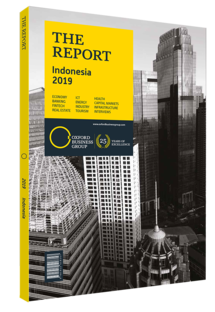Domestic demand and policy initiatives to support economic growth in Indonesia
The economy expanded by 5.2% in 2018, according to official figures from Statistics Indonesia, slightly above the previous year’s growth rate of 5.1%. This was driven by gains in major industries: construction grew by 6.3%, vehicle and retail trade by 5.1%, processing by 4.2% and agriculture by 3.9%. Strong performances were also seen in sectors such as ICT, which saw growth of 7.8%, and transport and storage, with 7.6%. These sectors benefitted from improved domestic demand, which, according to a statement released by Bank Indonesia (BI), the central bank, in November 2018, was projected to increase by 5.5% that year, driven by strong investment in government infrastructure projects. The GDP figures align with year-end growth projections of 5.1% from both the IMF and the Ministry of Finance (MoF); however, the rate is slightly below earlier predictions of 5.3% made by the MoF.
Interest Rates
In 2018 the BI also increased interest rates as part of an effort to stabilise the rupiah. The central bank raised its benchmark rate six times between May and November, from 4.25% to 6%, making this the first time rates had been increased since November 2014. These efforts were designed to stem a drop in value of the rupiah and a subsequent reduction in foreign currency reserves. The currency lost around 12% against the dollar from January to October, falling on the back of rising US interest rates and higher oil prices, which placed pressure on the current account deficit.
BI’s measures were met with some success at the close of 2018, with the currency regaining some lost ground and ending the year 5.7% down on its opening rates. Meanwhile, inflation closed the year at a steady 3.1% in December, with the BI confident the annual rate would remain within its target range of 2.5-4.5%, for both 2018 and 2019.
Stimulus Package
Moving forward, the government has renewed efforts to drive growth and boost foreign direct investment with the launch of a new economic stimulus package in November 2018. The package, the 16th to be released since September 2015, offers continued tax holidays to many industries operating in special economic zones, while also extending the scope of activities covered by earlier versions of the scheme, encompassing agri-processing and the digital economy. The announcement outlined plans to reform the country’s negative investment list, which defines the restrictions and barriers to foreign ownership across the economy (see Trade & Investment chapter).
Analysis from consultancy firm PwC predicted that the proposed changes, expected during 2019, would see 54 sectors removed from the list and therefore open up the possibility of 100% foreign ownership, while a series of others would have their foreign ownership threshold raised. The government noted that the most recent changes to the list, made in late 2016, resulted in a 108.6% and 82.5% increase in foreign and domestic direct investment, respectively. The incentives are expected to help support economic growth in 2019, which BI forecasts will expand by between 5.0% and 5.4%, helped by increases in domestic demand and improved exports.
Threats to Growth
While the economy is forecast to continue its solid rate of expansion, there are some factors that pose a risk to growth. Indonesia could be affected by the ongoing trade dispute between China and the US, with the possible expansion of tariffs holding the potential to cool the Chinese economy, one of its main export markets. Another factor that will impact the economy in the coming year is the forthcoming presidential election, scheduled for April. Though the lead-up to the poll may see increased state spending, resulting in a growth spurt for GDP, the focus of political attention on campaigning may slow the pace of economic reforms until after the election outcome is settled.
You have reached the limit of premium articles you can view for free.
Choose from the options below to purchase print or digital editions of our Reports. You can also purchase a website subscription giving you unlimited access to all of our Reports online for 12 months.
If you have already purchased this Report or have a website subscription, please login to continue.

